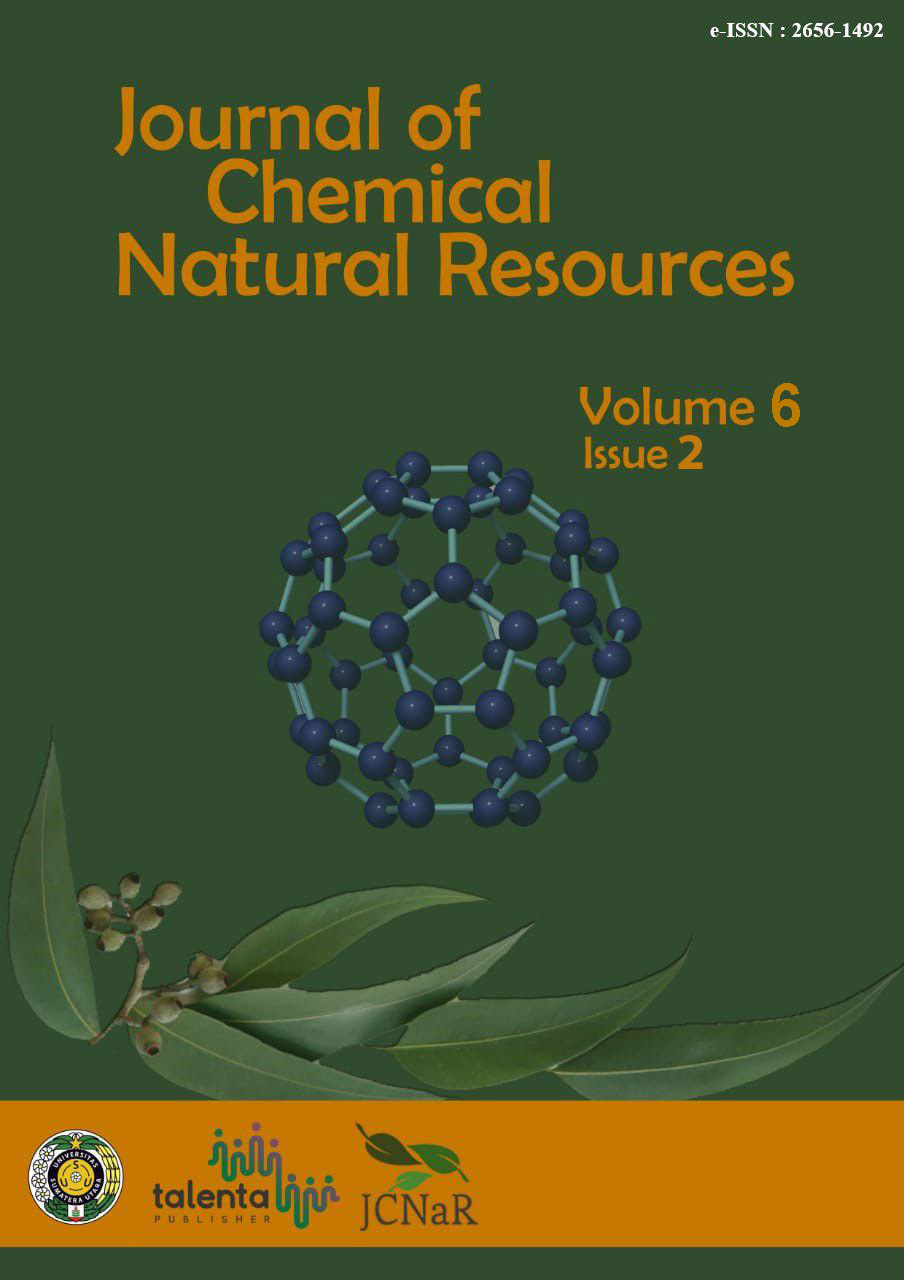Isolation of Flavonoid Compounds Derived from Buni Leaves (Antidesma bunius (L) Spreng.)
DOI:
https://doi.org/10.32734/jcnar.v6i2.18379Keywords:
Buni Plant Leaves, Extraction, Isoflavones, MacerationAbstract
The flavonoid compounds from the leaves of buni (A. bunius (L) Spreng.) have been isolated through a process of maceration utilizing methanol as the solvent. The concentrated methanol extract was combined with ethyl acetate. The concentrated ethyl acetate extract was subsequently dissolved in methanol and subjected to partition extraction using n-hexane. The concentrated methanol extract was acidified with 6% HCl, followed by partition extraction using chloroform. The concentrated chloroform extract was isolated using column chromatography, employing an eluent mixture of n-hexane and ethyl acetate in the following ratios: 90:10, 80:20, 70:30, and 60:40 (v/v). The compounds underwent purification via TLC preparative, resulting in a tawny paste with a mass of 30 mg and an Rf value of 0.31. The compound underwent additional identification through the application of Ultraviolet Visible (UV-Vis) spectroscopy, Fourier Transform-Infrared Spectroscopy (FT-IR), and Proton Nuclear Magnetic Resonance Spectroscopy (1H-NMR), leading to the conclusion that the flavonoid in question is isoflavone.
Downloads
References
M. C. Dias, D. C. G. A. Pinto, and A. M. S. Silva, “Plant flavonoids: Chemical characteristics and biological activity,†Molecules, vol. 26, no. 17, pp. 1–16, 2021, doi: 10.3390/molecules26175377.
A. Roy et al., “Flavonoids a Bioactive Compound from Medicinal Plants and Its Therapeutic Applications,†Biomed Res. Int., vol. 2022, 2022, doi: 10.1155/2022/5445291.
A. Ullah et al., “Important Flavonoids and Their Role as a Therapeutic Agent,†Molecules, vol. 25, pp. 1–39, 2020.
M. Shariful Islam, M. Sharif Ahammed, F. Islam Sukorno, S. Ferdowsy Koly, M. Morad Biswas, and S. Hossain, “A review on phytochemical and pharmacological potentials of Antidesma bunius,†J. Anal. Pharm. Res., vol. 7, no. 5, pp. 602–604, 2018, doi: 10.15406/japlr.2018.07.00289.
D. A. P. Kumaradewi, W. A. Subaidah, Y. Andayani, and A. Al-Mokaram, “Phytochemical Screening and Activity Test of Antioxidant Ethanol Extract of Buni Leaves (Antidesma bunius L. Spreng) Using DPPH Method,†J. Penelit. Pendidik. IPA, vol. 7, no. 2, pp. 275–280, 2021, doi: 10.29303/jppipa.v7i2.675.
F. Amalia and G. N. Afnani, “Extraction and Stability Test of Anthocyanin from Buni Fruits (Antidesma Bunius L) as an Alternative Natural and Safe Food Colorants,†J. Food Pharm. Sci., vol. 1, pp. 49–53, 2013, [Online]. Available: http://jurnal.ugm.ac.id/jfps/article/view/1844
S. Islam et al., “Estimation of phytochemical, antioxidant screening profile and thrombolytic activities of methanolic extract of Antidesma bunius L. leaf,†Hortic. Int. J., vol. 2, no. 6, 2018, doi: 10.15406/hij.2018.02.00077.
P. E. Hansen and J. Spanget-Larsen, “NMR and IR investigations of strong intramolecular hydrogen bonds,†Molecules, vol. 22, no. 4, 2017, doi: 10.3390/molecules22040552.
D. . Pavia, G. . Lampman, and G. . Kriz, Introduction to Spectroscopy: A Guide for Students of Organic Chemistry. Philadelphia: Saunders College, 1979.
N. Hutagalung and H. Sembiring, “Isolation and Identification of Flavonoids from Mundu Plant Leaves (Garcinia Dulcis (Roxb.) Kurz),†J. Chem. Nat. Resour., vol. 04, no. 02, pp. 137–145, 2022.

Downloads
Published
Issue
Section
License
Copyright (c) 2024 Journal of Chemical Natural Resources

This work is licensed under a Creative Commons Attribution-ShareAlike 4.0 International License.














